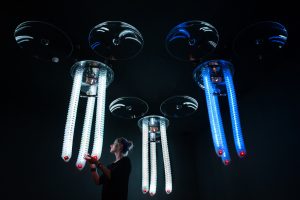
An interactive art installation that interested me was Petting Zoo by the architecture and design firm Minimaforms. This installation mimics the lifelike interactions animals have with humans through tubelike robots that hang from the ceiling. These robots have several sensors that can detect sounds, gestures, and touch that can encourage the robots to learn behaviors and personalities that evolve over time. For instance, the more a human interacts with the animal robot, the more it can become attached to the human.
I admire this project because I find it fascinating how the designers were able to capture complex human and animal emotions through artificial intelligence and robots. However, I find the idea of robots being able to evolve and develop emotions unnerving, and it makes me question the interactions humans and robots may have in the future. This installation was developed over several years by the two cofounders of Minimaforms, three designers, and eleven assistants. The designers utilized Kinect sensors to detect multiple people within the environment. In addition, the designers used Processing, which is a language that can make the robots coordinate with one another and allow for interactions with multiple people. Petting Zoo was inspired by The Senster by Edward Ihnatowicz, which was the first robotic sculpture. The designers also pulled inspiration from the work of Gordon Pask and Walter Grey Walter. This project’s ability to empathize with humans and animals show the potential of their interactions in the future. This project is one example of the development of artificial intelligence and how it contributes to creating a more futuristic society.
![[OLD FALL 2018] 15-104 • Introduction to Computing for Creative Practice](https://courses.ideate.cmu.edu/15-104/f2018/wp-content/uploads/2020/08/stop-banner.png)